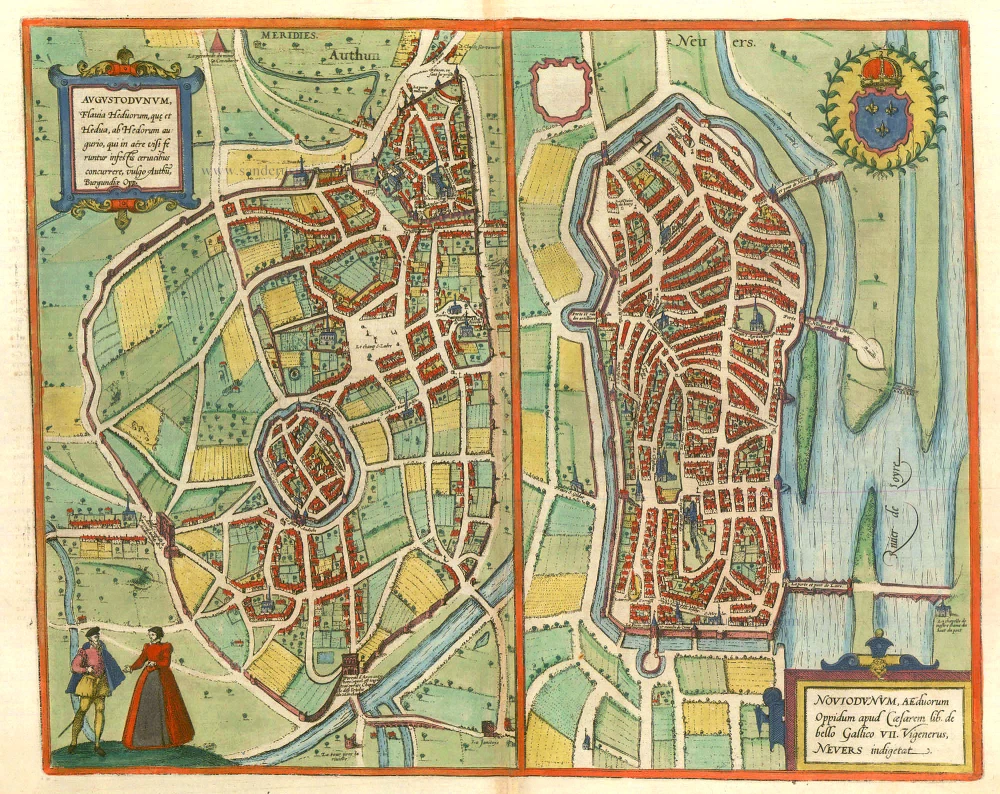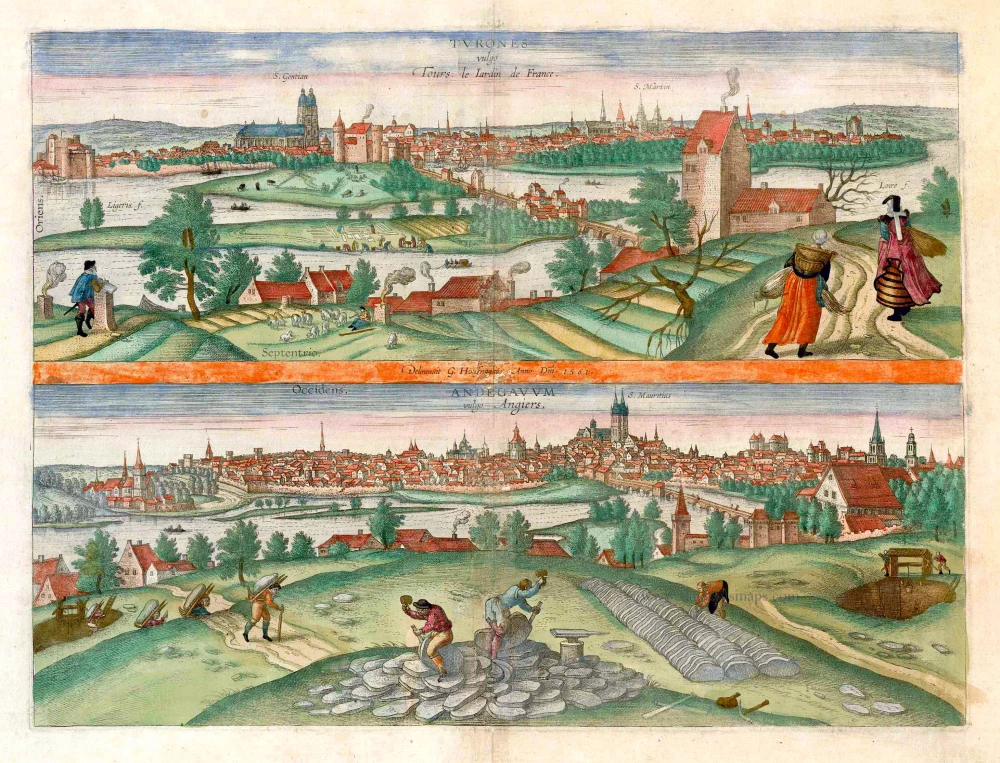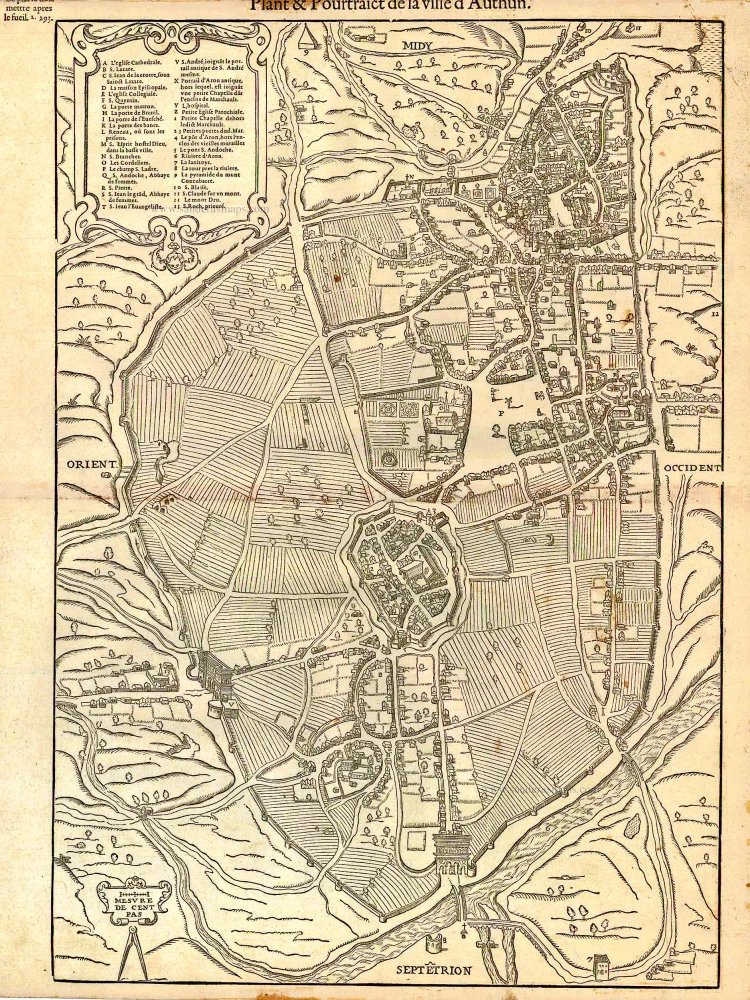Autun and Nevers, by Braun & Hogenberg. 1581-88
AUTUN
CARTOUCHE: Augustodunum, the Flavia of the Aedui, in French Autun, a town in Burgundy.
COMMENTARY BY BRAUN: "Autun lies at the foot of several mountains, it is a town in Burgundy with only a few buildings, except for the spot where the castle and the church of Saint-Lazare stand. This Lazarus was the brother of Mary Magdalene, who, after being resurrected from the dead by Christ, came to France to spread the Gospel after Christ's Ascension. His body was buried in this church and reverently preserved as a relic. [...] The other part of the town, now called Marchaux in French, was formerly the champ de mars."
The bird's-eye view from the west depicts a spacious tract of land bordered by city walls on the far side of the small Arroux River. Only two areas show higher-density development. The first is the oval district of Marchaux in the centre, whose exits are marked by two Roman gateways. Autun, which originally lay on the long-distance Via Agrippa trade route, was founded by Emperor Augustus following the suppression of the Gauls in 10 BC. Its Roman remains include the Temple of Janus (bottom right) and the pyramidal de Couhard tomb (top edge). The second, more densely settled quarter is the upper, or episcopal, town with the cathedral of Saint-Lazare. During the Middle Ages, the relics of St Lazarus attracted flocks of lepers, who made the pilgrimage to Autun hoping for a rapid cure.
Made after a woodcut from Belleforest, La Cosmographie universelle, Paris, 1575.
NEVERS
CARTOUCHE: Noviodunum, according to Vigenerus in the seventh book of Caesar's Bellum Gallico the city of the Aedui, locally called Nevers.
COMMENTARY BY BRAUN: "Noviodum, an important city in the Duchy of Nevers, lies on the Loire and takes its name from its location since donum once meant mountain or hill in Old French. For it lies on a hill where the Nièvre flows into the Loire. All the buildings are well protected by a secure ring wall, commanding towers and a deep moat."
This bird's-eye view shows the Burgundian city situated at the confluence of the Nièvre with the Loire and featuring numerous narrow alleys that wind through the elongated Old Town. Archaeological finds allow the city to be traced back to a settlement in Gallo-Roman times. Nevers was made a bishopric in the late 5th century AD; in the Middle Ages, it became the capital of the County and, in 1538, of the Duchy of Nivernais. The Palais Ducale in the city centre is one of central France's most important feudal edifices. Situated beneath the Ducal Palace is the cathedral of Saint-Cyr-et-Sainte-Juliette, which features two choirs. The Duchy of Nevers passed to the Italian Gonzaga family through the marriage of Henrietta of Cleves to Luigi Gonzaga in the second half of the 16th century. During this period, the city lay on an important trade route and was known for its cattle breeding and craft industries. Nevers would also owe the subsequent development of its prestigious faience industry to the Gonzaga family: since the 17th century it has been regarded as the ceramics capital of France. (Taschen)
Made after a woodcut from Belleforest, La Cosmographie Universelle, Paris, 1575.
Braun G. & Hogenberg F. and the Civitates Orbis Terrarum.
The Civitates Orbis Terrarum, also known as the 'Braun & Hogenberg', is a six-volume town atlas and the most excellent book of town views and plans ever published: 363 engravings, sometimes beautifully coloured. It was one of the best-selling works in the last quarter of the 16th century. Georg Braun, a skilled writer, wrote the text accompanying the plans and views on the verso. Many plates were engraved after the original drawings of a professional artist, Joris Hoefnagel (1542-1600). The first volume was published in Latin in 1572 and the sixth in 1617. Frans Hogenberg, a talented engraver, created the tables for volumes I through IV, and Simon van den Neuwel made those for volumes V and VI. Other contributors were cartographers Daniel Freese and Heinrich Rantzau, who provided valuable geographical information. Works by Jacob van Deventer, Sebastian Münster, and Johannes Stumpf were also used as references. Translations appeared in German and French, making the atlas accessible to a broader audience.
Since its original publication of volume 1 in 1572, the Civitates Orbis Terrarum has left an indelible mark on the history of cartography. Seven more editions followed the first volume in 1575, 1577, 1582, 1588, 1593, 1599, and 1612. Vol.2, initially released in 1575, saw subsequent editions in 1597 and 1612. The subsequent volumes, each a treasure trove of historical insights, graced the world in 1581, 1588, 1593, 1599, and 1606. The German translation of the first volume, a testament to its widespread appeal, debuted in 1574, followed by the French edition in 1575.
Several printers were involved: Theodor Graminaeus, Heinrich von Aich, Gottfried von Kempen, Johannis Sinniger, Bertram Buchholtz, and Peter von Brachel, all of whom worked in Cologne.
Georg Braun (1541-1622)
Georg Braun, the author of the text accompanying the plans and views in the Civitates Orbis Terrarum, was born in Cologne in 1541. After his studies in Cologne, he entered the Jesuit Order as a novice, indicating his commitment to learning and intellectual pursuits. In 1561, he obtained his bachelor's degree; in 1562, he received his Magister Artium, further demonstrating his academic achievements. Although he left the Jesuit Order, he continued his studies in theology, gaining a licentiate in theology. His theological background likely influenced the content and tone of the text in the Civitates Orbis Terrarum, adding a unique perspective to the work.
Frans Hogenberg (1535-1590)
Frans Hogenberg was a Flemish and German painter, engraver, and mapmaker. He was born in Mechelen as the son of Nicolaas Hogenberg.
By the end of the 1560s, Frans Hogenberg was employed upon Abraham Ortelius's Theatrum Orbis Terrarum, published in 1570; he is named an engraver of numerous maps. In 1568, he was banned from Antwerp by the Duke of Alva and travelled to London, where he stayed a few years before emigrating to Cologne. He immediately embarked on his two most important works, the Civitates, published in 1572 and the Geschichtsblätter, which appeared in several series from 1569 until about 1587.
Thanks to large-scale projects like the Geschichtsblätter and the Civitates, Hogenberg's social circumstances improved with each passing year. He died as a wealthy man in Cologne in 1590.
Augustodunum [on sheet with] Noviodunum.
Item Number: 20414 Authenticity Guarantee
Category: Antique maps > Europe > France - Cities
Old, antique map of Autun and Nevers by Braun & Hogenberg.
Title: Augustodunum [on sheet with] Noviodunum.
Date of the first edition: 1581.
Date of this map: 1581-88.
Copper engraving, printed on paper.
Size (not including margins): 340 x 420mm (13.39 x 16.54 inches).
Verso: Latin text.
Condition: Original coloured, excellent.
Condition Rating: A+.
From: Civitates Orbis Terrarum. . Liber tertius. Köln, G. Kempen, 1581-88. (Koeman, B&H3)
AUTUN
CARTOUCHE: Augustodunum, the Flavia of the Aedui, in French Autun, a town in Burgundy.
COMMENTARY BY BRAUN: "Autun lies at the foot of several mountains, it is a town in Burgundy with only a few buildings, except for the spot where the castle and the church of Saint-Lazare stand. This Lazarus was the brother of Mary Magdalene, who, after being resurrected from the dead by Christ, came to France to spread the Gospel after Christ's Ascension. His body was buried in this church and reverently preserved as a relic. [...] The other part of the town, now called Marchaux in French, was formerly the champ de mars."
The bird's-eye view from the west depicts a spacious tract of land bordered by city walls on the far side of the small Arroux River. Only two areas show higher-density development. The first is the oval district of Marchaux in the centre, whose exits are marked by two Roman gateways. Autun, which originally lay on the long-distance Via Agrippa trade route, was founded by Emperor Augustus following the suppression of the Gauls in 10 BC. Its Roman remains include the Temple of Janus (bottom right) and the pyramidal de Couhard tomb (top edge). The second, more densely settled quarter is the upper, or episcopal, town with the cathedral of Saint-Lazare. During the Middle Ages, the relics of St Lazarus attracted flocks of lepers, who made the pilgrimage to Autun hoping for a rapid cure.
Made after a woodcut from Belleforest, La Cosmographie universelle, Paris, 1575.
NEVERS
CARTOUCHE: Noviodunum, according to Vigenerus in the seventh book of Caesar's Bellum Gallico the city of the Aedui, locally called Nevers.
COMMENTARY BY BRAUN: "Noviodum, an important city in the Duchy of Nevers, lies on the Loire and takes its name from its location since donum once meant mountain or hill in Old French. For it lies on a hill where the Nièvre flows into the Loire. All the buildings are well protected by a secure ring wall, commanding towers and a deep moat."
This bird's-eye view shows the Burgundian city situated at the confluence of the Nièvre with the Loire and featuring numerous narrow alleys that wind through the elongated Old Town. Archaeological finds allow the city to be traced back to a settlement in Gallo-Roman times. Nevers was made a bishopric in the late 5th century AD; in the Middle Ages, it became the capital of the County and, in 1538, of the Duchy of Nivernais. The Palais Ducale in the city centre is one of central France's most important feudal edifices. Situated beneath the Ducal Palace is the cathedral of Saint-Cyr-et-Sainte-Juliette, which features two choirs. The Duchy of Nevers passed to the Italian Gonzaga family through the marriage of Henrietta of Cleves to Luigi Gonzaga in the second half of the 16th century. During this period, the city lay on an important trade route and was known for its cattle breeding and craft industries. Nevers would also owe the subsequent development of its prestigious faience industry to the Gonzaga family: since the 17th century it has been regarded as the ceramics capital of France. (Taschen)
Made after a woodcut from Belleforest, La Cosmographie Universelle, Paris, 1575.
Braun G. & Hogenberg F. and the Civitates Orbis Terrarum.
The Civitates Orbis Terrarum, also known as the 'Braun & Hogenberg', is a six-volume town atlas and the most excellent book of town views and plans ever published: 363 engravings, sometimes beautifully coloured. It was one of the best-selling works in the last quarter of the 16th century. Georg Braun, a skilled writer, wrote the text accompanying the plans and views on the verso. Many plates were engraved after the original drawings of a professional artist, Joris Hoefnagel (1542-1600). The first volume was published in Latin in 1572 and the sixth in 1617. Frans Hogenberg, a talented engraver, created the tables for volumes I through IV, and Simon van den Neuwel made those for volumes V and VI. Other contributors were cartographers Daniel Freese and Heinrich Rantzau, who provided valuable geographical information. Works by Jacob van Deventer, Sebastian Münster, and Johannes Stumpf were also used as references. Translations appeared in German and French, making the atlas accessible to a broader audience.
Since its original publication of volume 1 in 1572, the Civitates Orbis Terrarum has left an indelible mark on the history of cartography. Seven more editions followed the first volume in 1575, 1577, 1582, 1588, 1593, 1599, and 1612. Vol.2, initially released in 1575, saw subsequent editions in 1597 and 1612. The subsequent volumes, each a treasure trove of historical insights, graced the world in 1581, 1588, 1593, 1599, and 1606. The German translation of the first volume, a testament to its widespread appeal, debuted in 1574, followed by the French edition in 1575.
Several printers were involved: Theodor Graminaeus, Heinrich von Aich, Gottfried von Kempen, Johannis Sinniger, Bertram Buchholtz, and Peter von Brachel, all of whom worked in Cologne.
Georg Braun (1541-1622)
Georg Braun, the author of the text accompanying the plans and views in the Civitates Orbis Terrarum, was born in Cologne in 1541. After his studies in Cologne, he entered the Jesuit Order as a novice, indicating his commitment to learning and intellectual pursuits. In 1561, he obtained his bachelor's degree; in 1562, he received his Magister Artium, further demonstrating his academic achievements. Although he left the Jesuit Order, he continued his studies in theology, gaining a licentiate in theology. His theological background likely influenced the content and tone of the text in the Civitates Orbis Terrarum, adding a unique perspective to the work.
Frans Hogenberg (1535-1590)
Frans Hogenberg was a Flemish and German painter, engraver, and mapmaker. He was born in Mechelen as the son of Nicolaas Hogenberg.
By the end of the 1560s, Frans Hogenberg was employed upon Abraham Ortelius's Theatrum Orbis Terrarum, published in 1570; he is named an engraver of numerous maps. In 1568, he was banned from Antwerp by the Duke of Alva and travelled to London, where he stayed a few years before emigrating to Cologne. He immediately embarked on his two most important works, the Civitates, published in 1572 and the Geschichtsblätter, which appeared in several series from 1569 until about 1587.
Thanks to large-scale projects like the Geschichtsblätter and the Civitates, Hogenberg's social circumstances improved with each passing year. He died as a wealthy man in Cologne in 1590.




